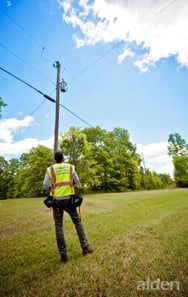Navigating the Field Asset Management Cycle: Collecting Data
 Effective field asset management is not a straight line from installation to decommission; it should be viewed as a continuous loop, a cycle of data acquisition, interpretation, and renewal for all your field assets. The question is: Where are you on the field asset management cycle? The second step is capturing data.
Effective field asset management is not a straight line from installation to decommission; it should be viewed as a continuous loop, a cycle of data acquisition, interpretation, and renewal for all your field assets. The question is: Where are you on the field asset management cycle? The second step is capturing data.
After the need for current data is identified, the next step is to leverage smart data capture software, implement proven process-driven services and employ experienced field technicians who understand how to collect a wide variety of information on your field assets.
You may need more effective data collection if you find yourself asking the following questions:
- Should I perform a broad inventory or targeted inspection? — If you do not know where you are, you won't have a good plan to get where you need to go. Simply knowing what assets you have and the condition they are in are the most important factors. What type of inventory or inspection you need will depend on your business goals. What questions are you trying to answer with this data? How will the final deliverable be used? What departments could benefit from certain data being collected? Answering these questions up front will help to determine whether a footprint inventory of all field assets is needed or perhaps a targeted inspection to locate NESC violations, for example, may solve your data question needs.
- Do I have the tools needed to capture the best data? — The data you need to make informed proactive decisions is out there. The trick is capturing it in a way that is reliable, trustworthy, and easy to use once you have it. Pen and paper no longer do the trick. Sophisticated data capture tools are needed for maximum effectiveness.
- Do I have the right people collecting data? — Inventories can be approached in many different ways, but not collecting field asset data with the end goal in mind will cost you in time and resources. A smart infrastructure asset management partner can assist with process creation, training and/or supplementing your team with expert personnel.
- Does my data collection process set me up for success? — All too often, complex inventory and data collection projects will not be as successful as possible because the effort itself is flawed. You need the end goals in mind at the beginning and involve all the groups in your organization that will eventually use the data, in order to collect exactly what is needed, no more, no less.
At Alden, we often see collection efforts that are under-resourced, not adequately supported by the right tool-set, or implemented without a clear directive to turn collected data into action. A better strategy shapes the collection process to reveal clarity and deliver the control you need over your field assets.
How to Collect the Best Data
Capturing accurate asset information efficiently in the field is vital for successful management. However, it does not end there. You need a plan to turn the collected inventory or inspection data into action.
A good plan takes not only smart data capture software, but services driven by process and experienced field techs. From location information to the health and condition of each asset to potential violations, an effective field asset management partner captures any attribute you require and even offers scalable inventory plans designed to improve your data collection efforts today and for the future.
Closing the Loop
So now you have captured great up-to-date data. To make your data usable, you must not stop at simply gathering it—you need the ability to gain insight from it. To make your newly acquired information useful over the long term, data records must be updated as conditions constantly change in the field. Processes must be in place to ensure that the information you have is the right information. As we mentioned before, the cycle is continuous.
You need a problem-solver, not just a data collector; a process creator, not just an inventory expert. You need a partner dedicated to helping you travel the field asset management cycle effectively, successfully, and with your end goals in mind. A good infrastructure asset management partner will help your trip around the field asset management cycle go smoothly and help you gain clarity and take control of the assets that make your operations run. And that makes everyone happy.
Wondering if your joint use management software or service provider can help you successfully travel the joint use cycle? Check out our list of 10 must-haves before you settle on a solution.

Comments